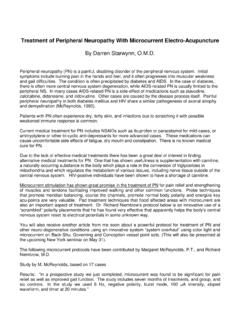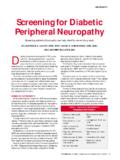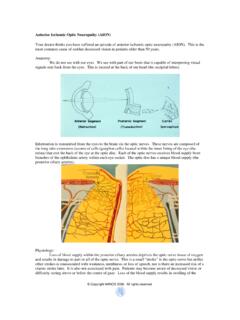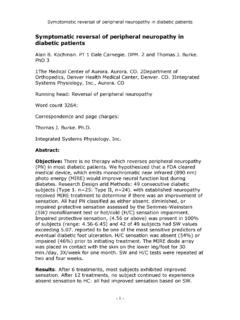Transcription of The Use of Transcutaneous Electrical Nerve …
1 The Use of Transcutaneous Electrical Nerve stimulation for the Treatment of Painful Diabetic NeuropathyKenneth Snow, MD, MBA ABSTRACTD iabetic Peripheral neuropathy (DPN) is the most common complication of diabetes affecting approximately 50% of people with diabetes in the United States. Painful diabetic neuropathy (PDN), the clinical scenario of neuropathic pain arising as a direct consequence of DPN, affects from 16% to 33% of people with diabetes. Patients with PDN have higher health care costs, higher rates of work and activity impairment and more frequent hospital-izations compared to patients with diabetes that do not have PDN. Several changes have been described in central neurons as well as peripheral nerves which help explain the development of neuropathic pain.
2 Treatment has centered on controlling risk factors known to exacerbate DPN such as hyperglycemia and cardiovascu-lar risk factors. In addition, symptom control with reduction in pain is a key component of the therapeutic approach. Unfortunately, complete resolution of pain is rare regard-less of the type of therapy used and pharmacologic thera-pies are associated with potential side effects. Transcuta-neous Electrical Nerve stimulation , the delivery of electricity across the intact surface of the skin to activate underlying nerves has been shown to provide symptomatic relief from various forms of pain, such as chronic pain due to PDN. This monograph reviews the available medical literature on the use of Transcutaneous Electrical Nerve stimulation for the treatment of PDN.
3 The sum total of the literature supports its use for the treatment of PDN. EPIDEMIOLOGYD iabetic Peripheral neuropathy (DPN), the most common complication of diabetes, is defined as a symmetrical, length-dependent distal sensorimotor polyneuropathy attributable to metabolic and microvascular alterations. Painful diabetic neuropathy (PDN) is the clinical scenario of neuropathic pain arising as a direct consequence of abnormalities in the peripheral somatosensory system in people with While the description of the pain is variable among patients, a number of terms are consis-tently used (see Table 1). A hallmark of PDN is that this pain is usually not exacerbated by walking but rather is worse at night when the patient is off their feet and their feet are This finding is in contrast to musculoskeletal pain or vascular insufficiency which is usually exacerbated by activity and relieved with rest.
4 The prevalence of DPN in the United States is approxi-mately 50% of patients with type 1 and type 2 PDN affects from 16% to 33% of people with diabetes. The estimates of how often it occurs vary depending on how PDN is defined and the nature of the popula-tion Regardless, PDN is clearly a common problem. Pain severity has been shown to affect the health outcomes of patients with PDN. Patients with severe PDN have annual health care costs of $17,000 compared to $11,000 and $9,000 for those with moderate or mild pain respectively. Those patients with severe PDN also had higher rates of work and activity Patients with PDN are hospitalized times more frequently and the cost of caring for these patients is nearly $6,000 more per year compared to patients without PDN can cause significant distress to patients with diabetes.
5 2 | The Use of Noninvasive Electrical Nerve stimulation for the Treatment of Painful Diabetic NeuropathyTable 1. Frequently used descriptions of PDN tingling burning lancinating shooting increased sensitivity (allodynia) pain on walking - walking barefoot on marbles or walking barefoot on hot sand sensations of heat or cold in the feet persistent achy feeling in the feet cramping sensations in the legsPDN can cause significant distress to patients with diabetes. Other compli-cations of diabetes such as mild retinopathy and nephropathy are painless and do not impact on the patient s quality of life early in their course. PDN sends the patient a clear message that diabetes is having a negative impact on their Use of Noninvasive Electrical Nerve stimulation for the Treatment of Painful Diabetic neuropathy | 3 PATHOPHYSIOLOGY Melzack and Wall in 1965 proposed a pain gate where impulses from small unmyelinated C fibers carrying pain signals and myelinated A fibers carrying light touch and pressure signals enter the dorsal horn of the spinal If the Electrical impulses from C fibers outnumber those from the A fibers then the gate opens allowing transmission of the pain signals.
6 If, on the other hand, the signal from A fibers predominates, then the gate is closed and pain is inhibited. One example of this gating effect is rubbing an area after trauma resulting in closing of the gate and a lessening of pain. Various changes affecting central neurons and peripheral nerves have been described which may help explain neuropathic pain. Some of these changes are listed below: Peripheral Nerve damage has been shown to cause neurons in the dorsal horn to be aberrantly innervated by A fibers rather than being innervated by C ,17 This input could lead to inappropriate responses to innocuous peripheral ,18 Changes to peripheral nerves leads to activation of N-methyl-D-aspartate (NMDA) receptors located in the dorsal horn of the spinal ,19 This activation leads to an increase in depolarization of spinal cord neurons with larger post-synaptic potentials and increased excitability of central Sodium channels are increased at the site of axonal damage as well as along the length of the axon.
7 The increased number of channels increases the likelihood of ectopic Electrical impulses in pain Rat models have demonstrated increased C fiber activity arising spontaneously in dorsal root ganglion21 and studies by Burcheil showed that spontaneous discharges in afferent axons were more common in hyperglycemic This increased stimulation leads to increased nociceptive signals transmitted through the gating system described earlier. TREATMENT Glycemic control plays a role in the development and progression of DPN. Hallmark studies such as the DCCT have shown that tight glycemic control can prevent the development of DPN or limit its Evidence proving that good glycemic control will actually improve neuropathy is more limited.
8 A few small studies have shown improvement in DPN including pain symptoms with intensive glycemic Perkins demonstrated an improvement in DPN in patients with improved glyce-mic control or triglyceride Regardless, controlling blood glucose is part of the standard of care for patients Other complications of diabetes such as mild retinopathy and nephropathy are painless and do not impact on the patient s quality of life early in their course. PDN sends the patient a clear message that diabetes is having a negative impact on their well-being. In addition, living with chronic pain from PDN has been shown to have a negative impact on patients quality of life. A recent study identified PDN as having a substantial impact on the quality of life of patients with diabetes com-parable to amputation.
9 PDN had a greater impact than other serious conditions including dialysis and Because of the worsening of symptoms at night, patients may have problems falling asleep resulting in a state of sleep ,11 Patients are more likely to have employment In addition, patients with severe PDN have a marked reduction in exercise tolerance limiting a key form of therapy for patients with type 2 PDN interferes with patients self-management of their diabetes through decreased activity and loss of Finally, patients with PDN have greater anxiety and A recent study identified PDN as having a substantial impact on the quality of life of patients with diabetes comparable to pharmacologic therapies for PDN are associated with potential side effects.
10 Intolerance can lead to discontinu-ation of therapy or is dose In one population based study, of patients with PDN, never reported their symptoms to their treating physician and had never received treatment for their painful symptoms. Thus, over 50% of patients with PDN did not receive any therapy for their Use of Transcutaneous Electrical Nerve StimulationTranscutaneous Electrical Nerve stimulation is the delivery of electricity across the intact surface of the skin to activate underlying nerves with the objective of providing symptom-atic relief from various forms of pain, such as chronic pain due to A number of recent systematic literature reviews and meta-analyses concluded that transcutane-ous Electrical Nerve stimulation may be an effective and safe treatment for painful diabetic However, there is a need for additional well designed, larger, randomized clinical trials to solidify these conclusions.




